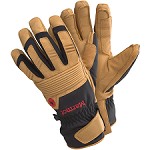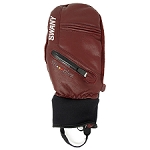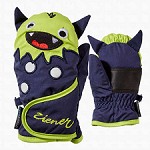A Barrabes guide on the different types of gloves on the market and how to choose the right gloves for each kind of activity

Gloves are an essential item for winter and snow activities. Photo: Daniel Vega
Gloves are an essential element during any outdoor activity in winter or bad weather. Our extremities are highly sensitive to the cold, due to reduced blood flow and being furthest away from the heart. Gloves are essential for protecting your hands and without them outdoor adventures would be no more than a dream for most of us. The main purpose of gloves is clearly to protect against the cold. However, this protection shouldn’t impede the use of our hands, which are one of the most important tools for mountaineering; gripping a rock, holding an ice-axe or carabiner or undoing a zip are just a few of the ways we use our hands. For this reason, different kinds of gloves are required for different activities. As a general rule, a mountaineer needs greater hand agility, while an alpine skier or hiker has reduced hand movement and therefore requires greater insulation.
Gloves vs Mittens
The main advantage of mittens is that they provide greater warmth due to the fingers being together. However, this makes your fingers less agile and therefore able to carry out fewer tasks. In extreme climates or if you are particularly sensitive to the cold, mittens are an excellent solution for activities which do not require the intense use of your hands (e.g. alpine skiing).

Salomon Native Mitten W, women's alpine ski mitten
Bear in mind however, that if you find you have to repeatedly remove your mittens to carry out a task, your hands will probably end up feeling colder than if you wore gloves designed to allow hand movement. Mittens with down insulation are usually used for expeditions. They are quite bulky but provide greater heat retention.

The Right Size
Gloves which are too big will reduce agility of movement. However in no case should we choose tight gloves for increased agility. If the fingers are too tight, rather than offering protection, they will reduce blood circulation and this can even lead to frost bite in extreme situations. Down is not usually used as insulation in gloves for this reason, except for expedition mitts. The increased volume makes them tighter around your fingers and this in turn inhibits dexterity and the only way to avoid this is to make oversized gloves or mitts.
Gauntlet or Short Glove?
Gloves with a long gauntlet are designed to wear over the sleeve. They offer greater protection against the elements and keep out snow and rain. The inconvenience is their greater volume which, in technical situations, can get in the way. Apart from their increased protection, long gauntlets are easier to put on and take off, which is appreciated in extreme climates.

Marmot Exum Guide Glove
Gloves without a gauntlet are designed to be worn under the sleeve. They take up less volume and allow greater agility for hand movement. However they offer reduced protection, and snow and rain get into the glove or up the sleeve more easily than with gloves with a gauntlet. There is no right or wrong when choosing a model with or without gauntlets. It is rather a question of getting the combination of protection and agility correct. Some brands make the same glove with or without a gauntlet for this reason.

Marmot Exum Guide Undercuff Glove (short model)
Protection Against the Elements? With a Membrane?
As with other outdoor, snow and ski garments, it is impossible to find one pair of gloves that functions equally well in every situation. A trail runner on a cool, dry winter’s day would probably find a pair of fleece gloves to be sufficient due to their warmth, breathability and freedom of movement, while a pair of ski gloves would cause overheating and discomfort.

Lowe Alpine Aleutian Glove, fleece gloves
Waterproof gloves are essential for snow and wet environments and this kind of protection is usually achieved with a waterproof and breathable membrane to keep out the rain and to wick perspiration away from your skin.
Insulation
All gloves provide a certain amount of warmth, depending on their construction. Fleece or fine gloves provide warmth from the actual material they are made from, but most gloves, while the inner and outer materials protect against the elements, body heat is accumulated in the insulation, so this is an essential part of the glove. The better the warmth, weight and volume ratio of the insulation, the better the glove. A quality glove will offer maximum warmth and agility with minimum volume.

Level Bliss Sunshine W. Women's alpine ski gloves with Primaloft synthetic insulation
Double Glove
Double gloves consist of an outer glove with a fleece liner. However even if your gloves do not have a double construction, it is an excellent idea to wear a thin liner underneath your gloves in extreme climates. It may not seem obvious, but liner gloves help a great deal to retain warmth and also provide protection if you need to remove the outer glove for taking a photo or something similar. As liners are so fine and lightweight, they don’t take up any room in your pack. Silk liners work particularly well.

Extremities Silk Liner Glove.
The Right Gloves for Every Activity
To choose the right glove for a particular activity you have to compromise between protection against the cold and the elements and agility. The warmer a glove needs to be, the more insulation it requires and this means losing out on agility. This issue is partly solved by choosing high quality insulation which provides increased warmth with minimum volume and weight. Even so, you will need to compromise at some point to find the right balance. And you will have to decide what you really need (we do not all respond in the same way to the cold) and what activity you plan to use them for.

Arc'teryx Alpha FL Glove. An agile, reinforced mountaineering glove
For example, a mountaineering glove needs to be more agile than an alpine ski glove. The design is different and can include little or no insulation in the palm, while providing reinforcement in this area. These gloves provide protection, but dexterity is also important. Keeping your hands active helps keep out the cold, so thermal protection for these activities is slightly less of an issue.
The more agility required, the more a glove design looks like a “work glove”. An all round mountaineering glove is therefore very different to one designed for dry tooling or ice-climbing which requires minimum volume and enhanced freedom of movement.

Black Diamond Punisher Glove, for ice climbing and dry-tooling.
An alpine skier’s hand stays in a fairly fixed position and agility is therefore not required. This means insulation can be increased to compensate for this lack of hand movement.

Leki Stella S Glove W, a warm alpine ski glove for women
Unless you are an experienced skier or technical mountaineer, a versatile mountain or ski glove are enough for most situations. However, as we mentioned, a thick glove causes heat loss if you need to remove the glove repeatedly to carry out certain tasks.
Reinforcements
One of the main differences in the design of different gloves lies in the reinforcements.
Mountaineering gloves have the most reinforcements. They are usually made of durable fabric, such as waterproof leather, on the palm and insulation is usually reduced in this area to compensate. Other reinforced areas are the finger tips and back of hand.

Rab Guide Glove Long, with reinforced areas
Some gloves have padded reinforcements on the fingers and knuckles, especially if they are designed for ice or alpine climbing. This feature is also used for the construction of ski gloves and protects when skiing through forests, for example.
Pre-formed
Most gloves nowadays are designed with slightly bent fingers for a more ergonomic fit.
This is for two reasons:
- The bent fingers save your fingers having to work as hard to close over a pole or rock.
- If you try to close your fingers while wearing a flat glove, the fabric will wrinkle in the palm area causing discomfort.
A Few Features to Consider
- Most mountain and ski gloves are made with a piece of soft suede on the thumb for cleaning your goggles.
- Most gloves have a wrist attachment band which prevents them falling off when removed.
- More and more gloves nowadays are made with screen touch fingers, so they don’t have to be removed when using a mobile.

Marmot Connect Glove, touch screen compatible
See the entire Barrabes range of gloves





















Leave a comment
Be the first to comment on this article.